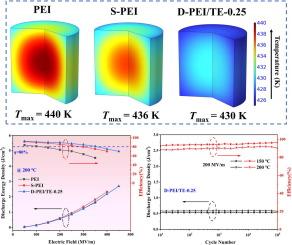通过化学和物理相互作用的协同交联增强全有机电介质薄膜的高温储能性能
IF 13.2
1区 工程技术
Q1 ENGINEERING, CHEMICAL
引用次数: 0
摘要
先进的电子设备和能源系统迫切需要能提供高放电能量密度和储能效率的高温聚合物电介质。然而,由于漏电流密度和能量损失显著增加,大多数聚合物的电容特性在高温下会急剧恶化。本文采用了一种新的设计方法来制造具有化学和物理协同交联网络的高温聚醚酰亚胺(PEI)电介质,通过胺交联剂和三庚烯(TE)与 PEI 链段之间带相反电荷的苯基的静电作用制备双交联 PEI 电介质。与未交联和单交联聚合物相比,得益于交联位点的增加,双交联 PEI 薄膜的 Tg、模量和带隙同时得到提高。同时,具有双交联网络的 PEI 显示出更高的链堆积密度,有效地减少了电荷载流子的平均运动路径,降低了聚合物电介质内部的传导损耗。因此,含有 0.25 wt% TE 的双交联 PEI 在 200 ℃ 下可提供 2.69 J/cm3 的出色放电能量密度,并在 100,000 次充放电循环后仍能保持良好的循环性。此外,有限元分析和分子动力学模拟进一步证实,在双交联聚合物电介质中形成的焦耳热更少、链结构更紧密。这项研究为制备用于高温应用的高性能聚合物电介质提供了一种新方法。本文章由计算机程序翻译,如有差异,请以英文原文为准。

Enhanced high-temperature energy storage performance in all-organic dielectric films through synergistic crosslinking of chemical and physical interaction
Advanced electronic devices and energy systems urgently require high-temperature polymer dielectrics that can offer both high discharge energy density and energy storage efficiency. However, the capacitive properties of most polymers sharply deteriorate at elevated temperatures, due to the significant rise in leakage current density and energy loss. Herein, a new design approach is adopted to fabricate high-temperature polyetherimide (PEI) dielectrics with chemical and physical cooperative crosslinking networks, the dual-crosslinked PEI dielectrics are prepared through amine crosslinking agent and the electrostatic interaction of oppositely charged phenyl groups between triptycene (TE) and PEI chain segments. Benefiting from the increased crosslinking sites, the dual-crosslinked PEI films achieve the simultaneously enhancement in Tg, modulus and bandgap compared to un-crosslinked and single-crosslinked polymers. Meanwhile, the PEI with dual-crosslinked network displays higher chain packing density, effectively reducing the mean motion pathways of charge carriers and the conduction loss inside polymer dielectric. Consequently, the dual-crosslinked PEI containing 0.25 wt% TE delivers an outstanding discharge energy density of 2.69 J/cm3 and retains excellent cyclability after 100,000 charge–discharge cycles at 200 ℃. Additionally, finite element analysis and molecular dynamics simulation further confirm that less Joule heat and tighter chain structure are formed in the dual-crosslinked polymer dielectric. This research offers a novel methodology to prepare high-performance polymer dielectrics for high-temperature applications.
求助全文
通过发布文献求助,成功后即可免费获取论文全文。
去求助
来源期刊

Chemical Engineering Journal
工程技术-工程:化工
CiteScore
21.70
自引率
9.30%
发文量
6781
审稿时长
2.4 months
期刊介绍:
The Chemical Engineering Journal is an international research journal that invites contributions of original and novel fundamental research. It aims to provide an international platform for presenting original fundamental research, interpretative reviews, and discussions on new developments in chemical engineering. The journal welcomes papers that describe novel theory and its practical application, as well as those that demonstrate the transfer of techniques from other disciplines. It also welcomes reports on carefully conducted experimental work that is soundly interpreted. The main focus of the journal is on original and rigorous research results that have broad significance. The Catalysis section within the Chemical Engineering Journal focuses specifically on Experimental and Theoretical studies in the fields of heterogeneous catalysis, molecular catalysis, and biocatalysis. These studies have industrial impact on various sectors such as chemicals, energy, materials, foods, healthcare, and environmental protection.
 求助内容:
求助内容: 应助结果提醒方式:
应助结果提醒方式:


